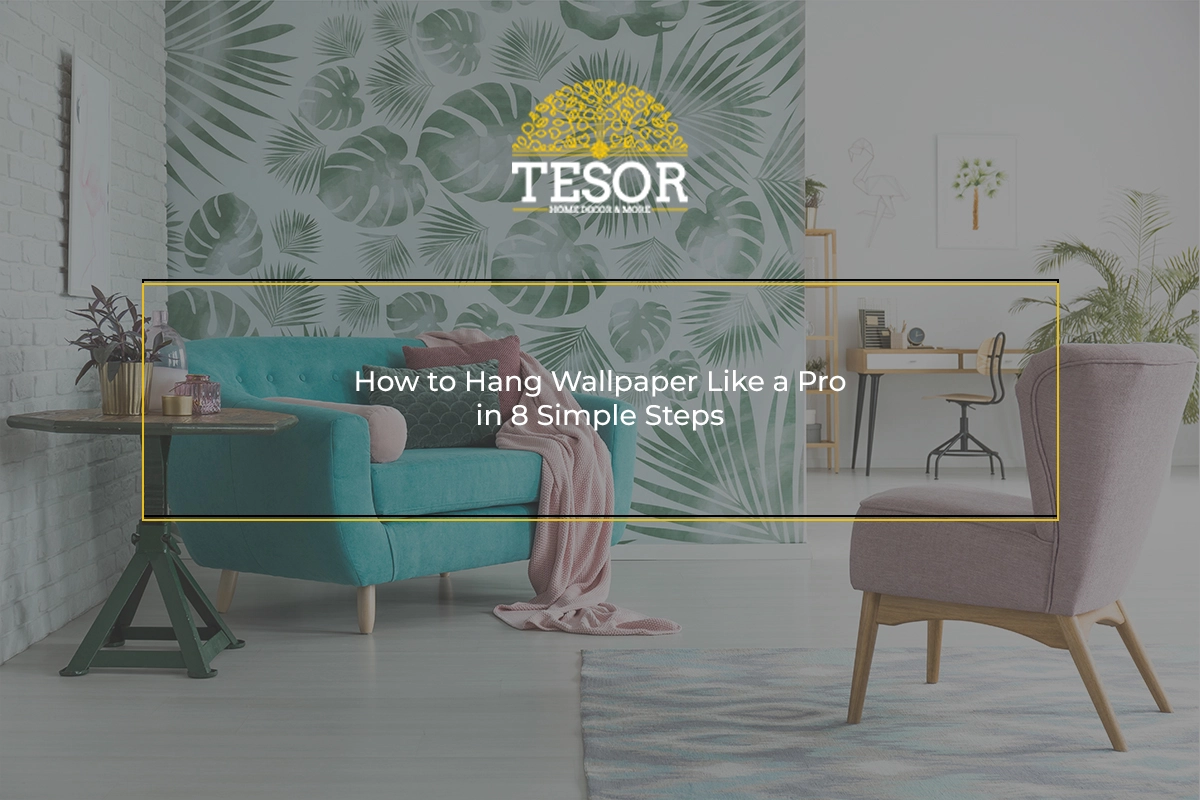
8 Easy Steps to Hang Wallpaper Like a Pro
It’s fascinating how wallpaper was first used in China, back in 200 B.C., and today, it has evolved so much that it’s making a major comeback—and we believe it’s here to stay.
However, most people hesitate to invest in wallpapers because they need to spend a lot on hiring a pro to hang wallpapers. But what if we told you, even you can pull off this job? There’s no rocket science to it. All you need is patience, precision and to follow the steps in this blog on “How to hang wallpaper like a pro”!
How to Choose a Wallpaper for Your Room?
Before you understand how to hang wallpapers, it’s important for you to choose a wallpaper depending on how durable you need it to be, how easy you want it to hang, and the overall vibe you’re going for.
- Pre-Pasted vs. Non-Pasted Wallpaper
Pre-pasted wallpaper already has adhesive on it, making it easy to apply, while non-pasted wallpaper needs you to add your own paste but gives you a little extra control.
- Wallpaper Materials
From vinyl for easy cleaning to classic paper and even textured fabric, each material brings its own look and feel to your walls, so make sure to pick the one that fits your style best.
- Wallpaper Cost
Of course, you can’t possibly ignore this factor. Wallpaper comes in a range of prices, depending on the material, brand, and design details. Investing a little more can often mean a longer-lasting, more intricate pattern.
Everything You’ll Need Before You Get Started:
- Equipment/Tools:
- Bucket and sponge
- Putty knife
- Sandpaper
- Trays and rolling brush
- Measuring tape
- Level
- Pencil
- Scissors
- Blade
- Smoothing tool
- Materials:
- Paint (If required)
- Wallpaper
- Wallpaper primer
- Wallpaper adhesive
- Warm water and vinegar
How to Hang Wallpaper Like a Pro in 8 Simple Steps
1. Get Your Walls Ready & Map Out the Room
Begin by planning where your wallpaper will go and also make sure that your key design is centered on the focal wall. Measure and mark the midpoint of the wall.
For preparation, remove any items from the wall and clean it using a water-vinegar solution. Wipe it down and let it dry for 24 hours. If there are any uneven or rough patches, make sure to use sandpaper and flatten it out to achieve a smooth surface.
2. Prime the Surface
Applying a wallpaper primer helps your wallpaper stick better and ensures a smooth, even surface. This step not only enhances the finishes but also prevents peeling or wearing off of the wallpaper, so that your walls stay looking great for longer.
3. Mark Your Lines for Perfect Placement
To make wallpaper application easier, measure and cut your wallpaper into manageable strips.
Start from the left, mark a 2-foot distance, and draw a straight line using a leveller. These lines will help you align each strip accurately and avoid tilting.
4. Measure & Pre-Cut Your Wallpaper
Measure the wall height and cut each wallpaper panel accordingly, leaving a bit of extra length at the top and bottom. Mark cutouts for outlets or switches on the back before cutting. Once done, take a pair of scissors and cut out the wallpaper carefully.
5. Add Wallpaper Adhesive
For traditional wallpaper, apply adhesive to the back of each panel. Let the adhesive stay for 3 minutes and then proceed to the next step or simply follow the wallpaper’s instructions for adhesive drying times for the best results.
6. Position & Hang Wallpaper
Preferably align the wallpaper from the corner, along with the plumb lines. Start by positioning the paper at the top level line, then smooth out any air bubbles using a smoothing tool, working from the centre down. Overlap the edges slightly before pressing them together with a seam roller to achieve seamless joints. Keep applying adhesive and repeat the step until everything is covered.
7. Smooth Away Air Bubbles
To give a neat look to your wallpaper, ensure to go back over the panels and smooth out bubbles with a smoothing tool. The best way to do it is by starting from the middle and pushing away the bubbles towards the edges.
8. Trim the Edges for a Crisp Finish
Use a utility knife or a blade to trim out the extra wallpaper along the edges for a crisp finish.
Tip: A level can help you keep lines straight while cutting.
You might also be interested in reading this blog: 5 best wallpaper designs for drawing room in Bangalore
Common Wallpapering Issues and How Professionals Fix Them
1. Air Bubbles
Issue: Air bubbles can appear if the wallpaper isn’t applied smoothly, leaving pockets of air underneath the wallpaper. This gives a shabby appearance to the wallpaper.
Solution: Professionals use smoothing tools to gently push the air out from the centre to the edges. They also apply even pressure to ensure a flawless finish and may use a pin to release stubborn bubbles.
2. Seam Lifting
Issue: Sometimes the edges of wallpaper seams start to lift over time, creating an evident gap.
Solution: Experts apply extra adhesive at the seams and use a seam roller to ensure they bond securely. They also apply ample pressure on the seams to keep the paper tightly intact.
3. Uneven Application
Issue: Wallpaper can shift or stretch, only if it’s not hung properly.
Solution: Professionals often mark plumb lines to maintain straight lines from start to finish. They simultaneously check the alignment as they attach every inch of the paper.
4. Wallpaper Shrinking
Issue: Some wallpapers may shrink after being applied, especially if they absorb moisture.
Solution: To prevent shrinking, professionals ensure the wallpaper is thoroughly prepped and moistened. They also leave a little breathing gap at the edges to allow natural shrinking to occur.
Master the Art of Hanging Wallpaper with Tesor’s Premium Designs
Learning how to hang wallpaper is a fantastic skill, especially if you’re looking to save some money or add a personal touch to your home decor. With the right tools, preparation, and a little patience, you can achieve a professional-looking finish without hiring a contractor. Remember, the key is precision and following the steps carefully. The results will be worth the effort, and you’ll be proud to see your walls transformed with a fresh, stylish look. Happy wallpapering!
For those in Bangalore looking for high-quality wallpaper, Tesor is a trusted home décor store in Bangalore that offers a range of beautiful designs capable of elevating any space.
Get in touch with us today, visit our wallpaper shop and bring your walls to life!
Frequently Asked Questions (FAQs)
1. What is the easiest wallpaper to hang?
Non-woven (paste the wall) wallpaper is the easiest to install, as it doesn’t expand or contract
and offers a seamless finish. It’s the perfect option for beginners.
2. How do you apply easy wallpaper?
First, peel off 12 inches of the adhesive backing and align the wallpaper with your lines. Slowly smooth it down while you peel off the rest of the backing as you go.
3. Which type of wallpaper is best?
Pre-pasted vinyl and vinyl-coated wallpapers are popular for their easy application, durability, and
resistance to wear and tear.
4. Do I need a professional to hang wallpaper?
While small walls can be DIYed, larger or expensive wallpaper is best left to the experts to ensure the desired finished look.
5. How to stick wallpaper without bubbles?
The most ideal way to stick wallpaper without bubbles is by using a wallpaper syringe to inject
paste under the bubble, then smooth it out with a smoothing tool for a flawless finish. Apply gentle pressure to avoid damaging the wallpaper.





